Abstract
Papillary and surface micropuncture was used to assess the effects of a chronic metabolic acidosis on the renal tubular handling of ammonium by surface nephrons, juxtamedullary nephrons, and the terminal segment of collecting duct. Rats chronically fed ammonium chloride had an expected decline in arterial pH and bicarbonate concentration associated with a doubling in the amount of ammonium excreted and a decline in urine pH. The glomerular filtration rate and absolute delivery of water and sodium to micropuncture sites of surface and deep nephrons was not measurably altered. Ammonium delivery to the end of the proximal tubule increased from 853±102% to 1,197±142% (SE) of the filtered load of ammonium after the induction of metabolic acidosis. This increase was due to a rise in tubular fluid ammonium content from 2.31±0.23 to 4.06±0.28 mM/liter. After the induction of acidosis, absolute and fractional delivery of ammonium ion to the end of the distal tubule was less than to the end of the accessible portion of the proximal tubule. These findings indicate that ammonium is lost in the intervening segment.
Ammonium handling by deep nephrons was profoundly affected by acid loading. Absolute delivery to the bend of the loop of Henle increased twofold while fractional delivery rose from 1,222±108% to 1,780±132% of the filtered ammonium. This was due to a marked increase in ammonia entry. During acidosis, ammonium delivery to the terminal segment of the collecting duct was doubled (709±137% in controls vs. 1,415±150% in acidosis, P < 0.005) but did not change between proximal and tip collecting duct sites. In both groups of animals delivery of ammonium to the terminal segment of the collecting duct was greater than to end distal tubular micropuncture sites suggesting that ammonia entry occurred between these two sites. The differences in delivery was greater after the induction of a metabolic acidosis (887±140% vs. 384±144%, P < 0.05). Thus, the present study indicates that deep nephrons contribute to the adaptive increase in ammonium excretion seen during the induction of metabolic acidosis. The data also suggest that ammonia leaves the nephrons at a site(s) along the loop of Henle to enter the collecting duct and that the induction of a metabolic acidosis enhances this reentry.
Full text
PDF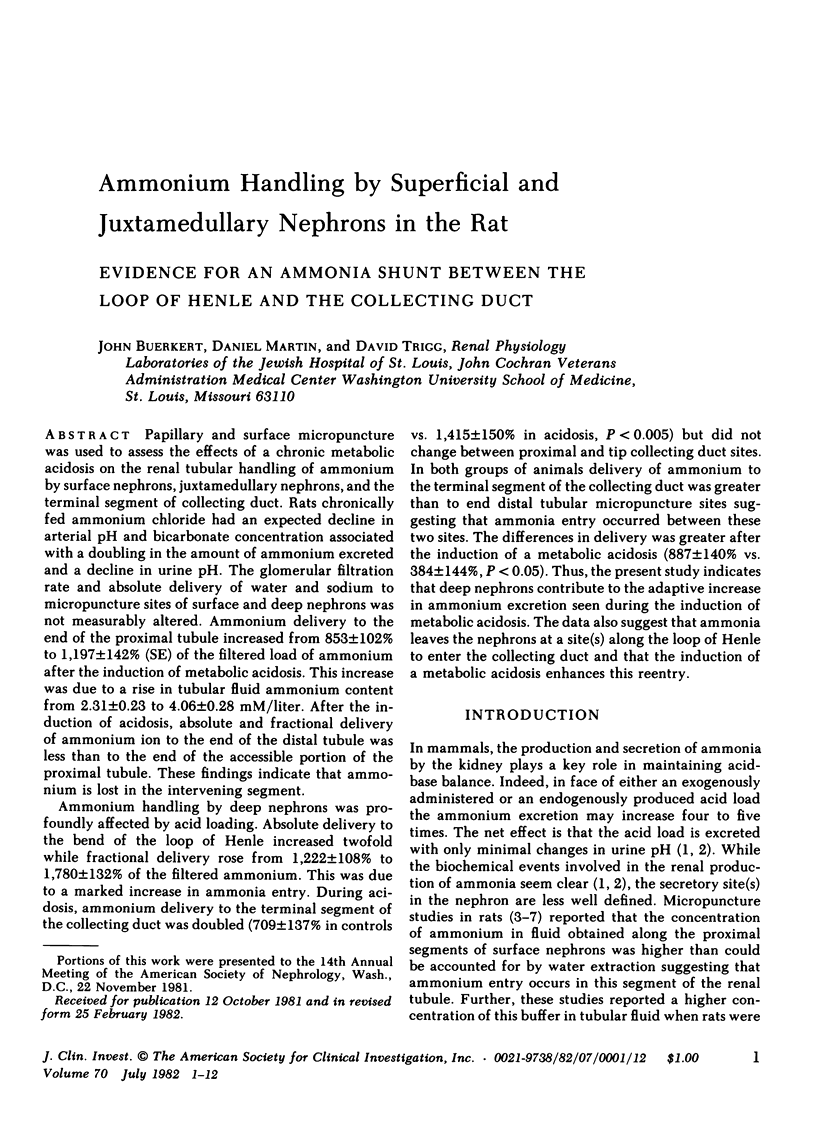

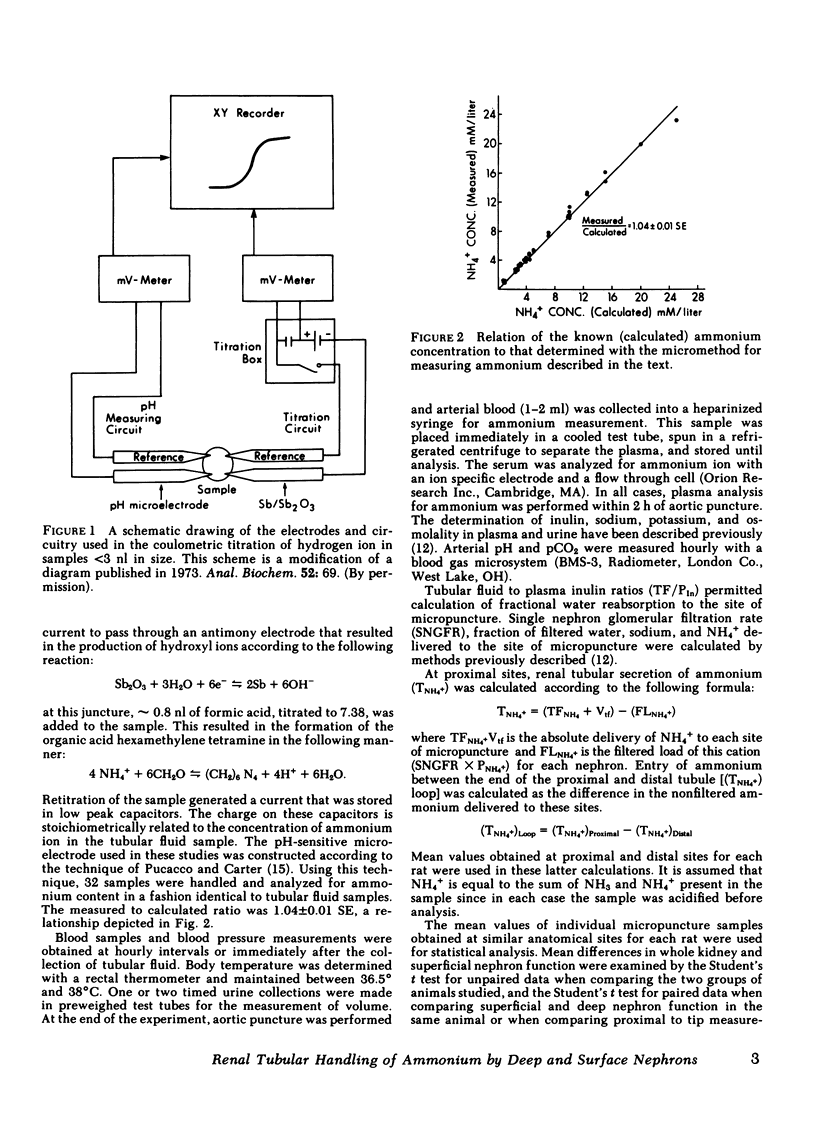

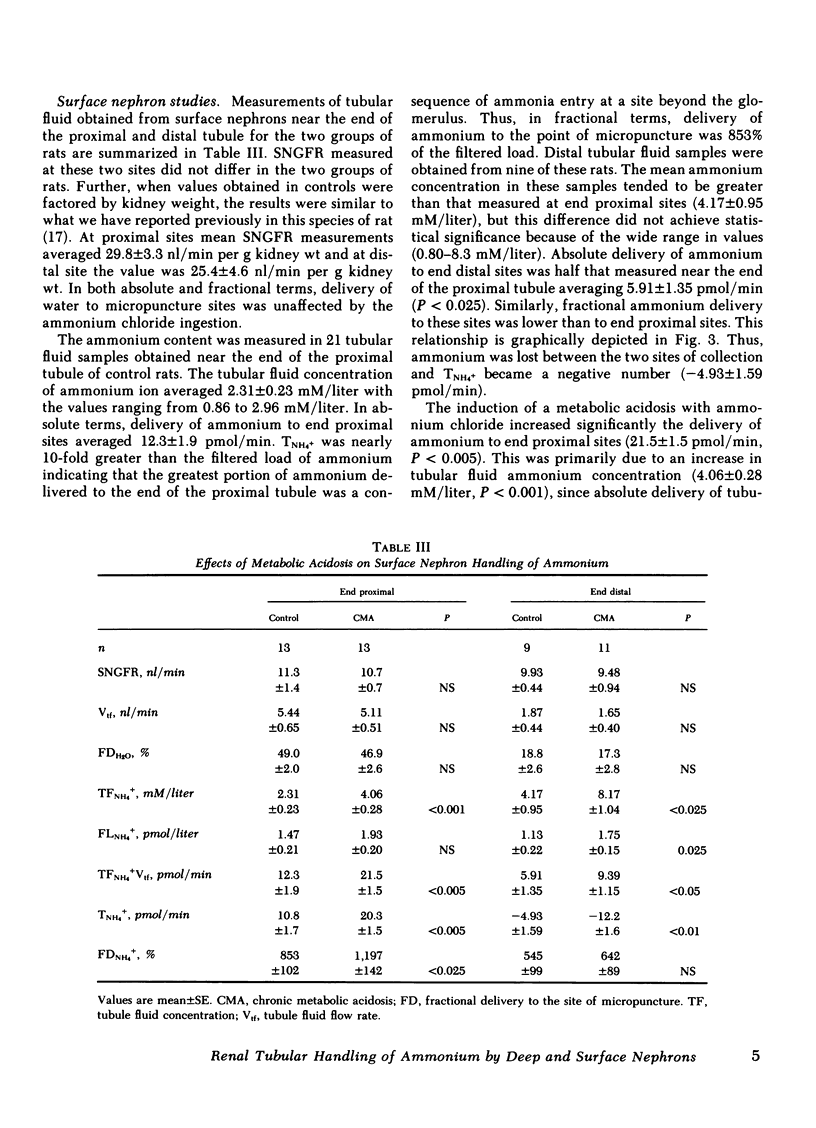

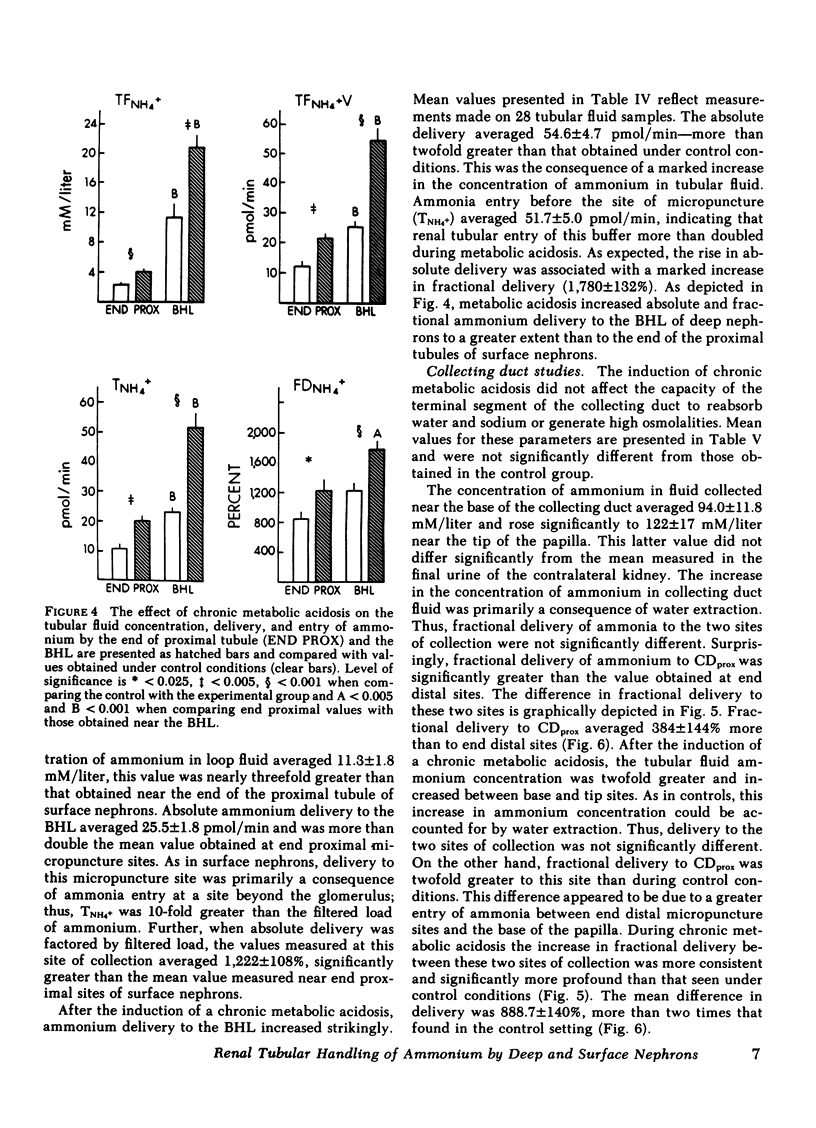


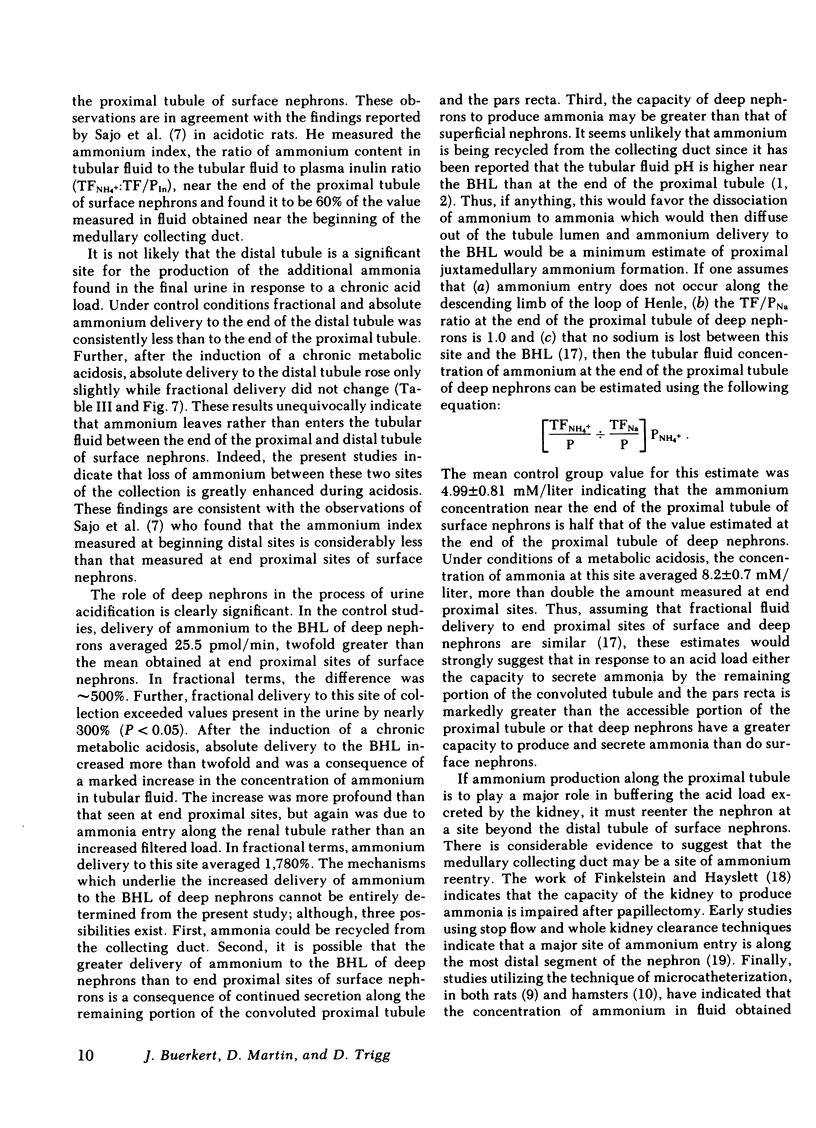


Selected References
These references are in PubMed. This may not be the complete list of references from this article.
- Buerkert J., Head M., Klahr S. Effects of acute bilateral ureteral obstruction on deep nephron and terminal collecting duct function in the young rat. J Clin Invest. 1977 Jun;59(6):1055–1065. doi: 10.1172/JCI108728. [DOI] [PMC free article] [PubMed] [Google Scholar]
- Buerkert J., Martin D., Prasad J., Chambless S., Klahr S. Response of deep nephrons and the terminal collecting duct to a reduction in renal mass. Am J Physiol. 1979 May;236(5):F454–F464. doi: 10.1152/ajprenal.1979.236.5.F454. [DOI] [PubMed] [Google Scholar]
- Curthoys N. P., Lowry O. H. The distribution of glutaminase isoenzymes in the various structures of the nephron in normal, acidotic, and alkalotic rat kidney. J Biol Chem. 1973 Jan 10;248(1):162–168. [PubMed] [Google Scholar]
- Finkelstein F. O., Hayslett J. P. Role of medullary structures in the functional adaptation of renal insufficiency. Kidney Int. 1974 Dec;6(6):419–425. doi: 10.1038/ki.1974.127. [DOI] [PubMed] [Google Scholar]
- GLABMAN S., KOSE R. M., GIEBISCH G. Micropuncture study of ammonia excretion in the rat. Am J Physiol. 1963 Jul;205:127–132. doi: 10.1152/ajplegacy.1963.205.1.127. [DOI] [PubMed] [Google Scholar]
- HAYES C. P., Jr, MAYSON J. S., OWEN E. E., ROBINSON R. R. A MICROPUNCTURE EVALUATION OF RENAL AMMONIA EXCRETION IN THE RAT. Am J Physiol. 1964 Jul;207:77–83. doi: 10.1152/ajplegacy.1964.207.1.77. [DOI] [PubMed] [Google Scholar]
- Karlmark B., Danielson B. G. Titratable acid, PCO2, bicarbonate and ammonium ions along the rat proximal tubule. Acta Physiol Scand. 1974 Jun;91(2):243–258. doi: 10.1111/j.1748-1716.1974.tb05681.x. [DOI] [PubMed] [Google Scholar]
- Karlmark B. The determination of titratable acid and ammonium ions in picomole amounts. Anal Biochem. 1973 Mar;52(1):69–82. doi: 10.1016/0003-2697(73)90332-1. [DOI] [PubMed] [Google Scholar]
- Oelert H., Uhlich E., Hills A. G. Messungen des Ammoniakdruckes in den corticalen Tubuli der Rattenniere. Pflugers Arch Gesamte Physiol Menschen Tiere. 1968;300(1):35–48. [PubMed] [Google Scholar]
- Pucacco L. R., Carter N. W. A glass-membrane pH microelectrode. Anal Biochem. 1976 Jun;73(2):501–512. doi: 10.1016/0003-2697(76)90200-1. [DOI] [PubMed] [Google Scholar]
- ROBINSON R. R., OWEN E. E. INTRARENAL DISTRIBUTION OF AMMONIA DURING DIURESIS AND ANTIDIURESIS. Am J Physiol. 1965 Jun;208:1129–1134. doi: 10.1152/ajplegacy.1965.208.6.1129. [DOI] [PubMed] [Google Scholar]
- SULLIVAN L. P. AMMONIUM EXCRETION DURING STOPPED FLOW: A HYPOTHETICAL AMMONIUM COUNTERCURRENT SYSTEM. Am J Physiol. 1965 Aug;209:273–282. doi: 10.1152/ajplegacy.1965.209.2.273. [DOI] [PubMed] [Google Scholar]
- Sajo I. M., Goldstein M. B., Sonnenberg H., Stinebaugh B. J., Wilson D. R., Halperin M. L. Sites of ammonia addition to tubular fluid in rats with chronic metabolic acidosis. Kidney Int. 1981 Sep;20(3):353–358. doi: 10.1038/ki.1981.146. [DOI] [PubMed] [Google Scholar]
- Solomon S., Alpert H. A method for determining titratable acidity in nanoliter samples of biological fluids. Anal Biochem. 1969 Nov;32(2):291–296. doi: 10.1016/0003-2697(69)90088-8. [DOI] [PubMed] [Google Scholar]
- Sonnenberg H., Cheema-Dhadli S., Goldstein M. B., Stinebaugh B. J., Wilson D. R., Halperin M. L. Ammonia addition into the medullary collecting duct of the rat. Kidney Int. 1981 Feb;19(2):281–287. doi: 10.1038/ki.1981.18. [DOI] [PubMed] [Google Scholar]
- ULLRICH K. J., HILGER H. H., KLUMPER J. D. Sekretion von Ammoniumionen in den Sammelrohren der Säugetierniere. Pflugers Arch. 1958;267(3):244–250. doi: 10.1007/BF00362428. [DOI] [PubMed] [Google Scholar]


